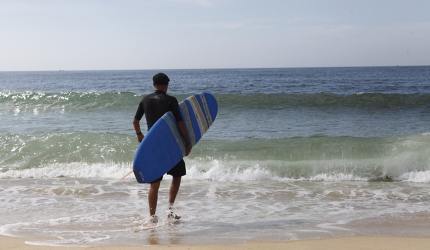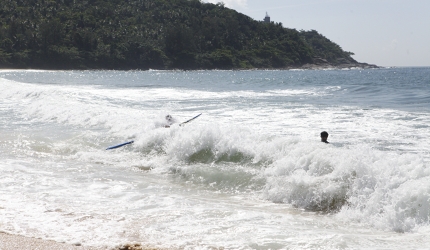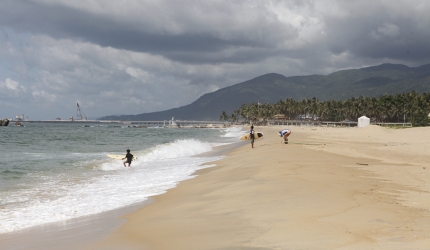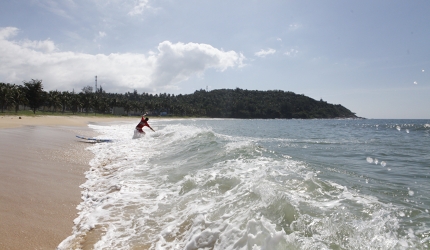Learning to surf at the Gate of Hell
We sent Daniel Fahey to the very cusp of the known world to catch some Chinese monsters. Here’s how he got on.
So this is it: the long-thought Gate of Hell; once the very edge of the known world, now the threshold to a very new one. As a turnstile to an eternal inferno, it’s not what I had envisioned.
Sure, the heat blisters. The sun, as a pre-curser to the Gate opening, is doing its blazing best as a warm up act. Yawning from a night shift, my watch is stretching its hands out at 0915, and already I’m in shorts.
Perhaps I expected something more apocalyptic than a rum-dark South China Sea; maybe someone more prophetic than the ocean goddess, Mazu, who busily kneads six foot waves into the soft, butter-blonde sands of Riyue Bay.
 Brendan, who runs Riyue Bay Surf Club, heads for the water
Brendan, who runs Riyue Bay Surf Club, heads for the waterDora Whitaker / Lonely Planet
Whatever I’d conceived, it didn’t include a beret-bearing, oak-skinned Californian surfer called Brendan and an all but abandoned paradisiacal beach. Yet at Hainan Island, the most southerly point of China, that’s exactly what I’ve found.
Brendan has been shacked up here for around seven years. His Riyue Bay Surf Club on the southeast of the island has all the indicia of a self-shaped surf spot: the hand painted driftwood signs (“No Sharks”, “No Limitations”); an acoustic guitar; a bar made from a surfboard, serving imported beer; year-round waves.
It’s the kind of sacred setting you yearn to find as you roll along in a rust-dusted campervan, board roped on top. A few intrepid surfers from Australia and the US have tempered these uncharted swells, now it’s the first generation of Chinese boarders who are starting to find their feet.
 Year-round waves make Hainan Island China's best surf spot
Year-round waves make Hainan Island China's best surf spotDora Whitaker / Lonely Planet
For centuries, Hainan was the end of China’s civilised world. The island was a real-life Diyu (Chinese purgatory), where banished Dynasty dissents were left abandoned between the fruits of the Forbidden City and an imminently impending afterlife.
In the 800s, Tang Dynasty prime minister and aspirant poet, Li Deyu, coloured Hainan as the “Gate of Hell”, but as a consequence of China’s ever-quickening evolution, it's an island still finding its identity. It swirls together the synchronised chaos of classic China (neon lights, noisy bikes and exotic street food) whilst alluding towards a future of homogeneous modernity (deluxe hotel chains, beach weddings and Western menus). Its lost coves, rainforest-rimmed mountains and deserted volcanic villages await rediscovery.
As my surf lesson with Brendan progresses from practising in the sand to lolloping upon grumbling tides, a school of local children ride waves further up the coast. They’re in the water wearing wetsuits and wilting straw hats. Face-kinis are also a regular sight on the beach.
“The locals don’t like to tan,” Brendan explains. “If they’re tanned, it means they work outside and people will think they’re poor. That’s why beaches are often empty in the day and get busier around five.”
 A school of local children prepare for a surf lesson
A school of local children prepare for a surf lessonDora Whitaker / Lonely Planet
There’s another issue facing China’s tenderfoot surfers: swimming. “Many locals can’t swim very well, so I have to teach them to swim before I can teach them to surf,” Brendan adds.
As I finally find my balance, I barrel roll off the board like a drunk reaching for his shoelaces. At least there are very few witnesses.
For the more accomplished, Hainan Island presents untapped tides and unfound treasures, especially now the government offers visa-free trips and visa on arrival.
Most surfers won’t go to the edge of the earth for the best waves, but where’s the adventure in that?
 The first generation of Chinese surfers are now finding their feet
The first generation of Chinese surfers are now finding their feetDora Whitaker / Lonely Planet
5 best places to surf in China
1) Ocean Bay Golf Club, Hainan Island
If you want the splash to yourself, this golden spot is the place to come. With swells that favour the brave, the winter waves from the deep water break are ideal for the more experienced.
2) East Beach, Zhujiajian Island
During typhoon season, East Beach on Zhujiajian Island has some great swells at high tide. You’re likely to be the only surfer tackling them too.
3) Houhai, Hainan Island
With reef and beach breaks, this palmed-treed sliver of paradise is blessed with a blossom of big waves. They’re powerful too, so longboards are recommended.
4) Tai Long Wan, Sai Kung, Hong Kong
Translating to Big Wave Bay, Tai Long Wan is a dazzling beach surrounded by emerald hills. The surf is just as impressive with good waves at Ham Tin and challenging hurlers at Tai Wan.
5) Jinzonglu, Sanya, Hainan Island
Hidden behind the Golden Palm Resort in Sanya, the southwestern winds that blow across Jinzonglu Beach mean this largely quiet spot has a reliable amount of big waves.
NEED TO KNOW
How to get there
There are no direct flights from the UK to Hainan Island. However, Hainan Airlines (global.hnair.com) fly from Beijing to Haikou Meilan International Airport on the north of the island and to Sanya Phoenix International Airport in the south. Riyue Bay is a few hours drive by car from either airport.
Where to stay
The Surf Club Hostel above the Riyue Bay Surf Club (www.surfinghainan.com) has basic mixed dorm rooms for eight to 12 people starting from 50 CNY a night.
If you’re after something a little more upmarket, try the wonderful Westin Hotel at Haitang Bay (www.starwoodhotels.com) which comes with spacious suites, sea views, its own private beach and a huge snaking swimming pool.
More information
Riyue Bay Surf Club: www.surfinghainan.com
Hainan Tourism: en.visithainan.gov.cn
Do you have any Feedback about this page?
© 2025 Columbus Travel Media Ltd. All rights reserved. No part of this site may be reproduced without our written permission, click here for information on Columbus Content Solutions.









 You know where
You know where